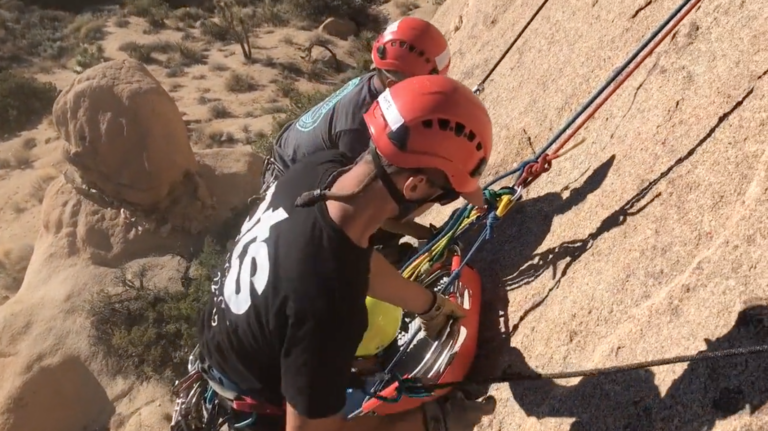While observing the Peak Rescue Institute’s 2017 Fall Course at Joshua Tree National Park, I encountered a pivotal moment in rope rescue training. The course focused on advanced technical rescue, and the skill being demonstrated was a 5th-class raising system operating in raise mode within a two-tension rope system (TTRS). Instructor Glenn Pinson shared critical insights on efficiency in managing TTRS, emphasizing how treating two ropes as one significantly amplifies gains in both effort and results. The timing and execution were flawless—a perfect blend of theory and practice in action.

The Science of Learning in Rope Rescue
Rescue training, especially in complex systems like TTRS, requires a solid grasp of both theory and hands-on application. People generally learn through three primary modalities:
- Auditory (Hearing and Verbal)
- Visual (Reading and Viewing)
- Kinesthetic (Touch and Movement)
While we all learn through a combination of these, each person has a dominant learning style. Understanding these preferences can enhance the effectiveness of rope rescue training:
- Visual Learners (65% of the population):
Visual learners thrive on diagrams, step-by-step guides, and demonstrations. In rope rescue, clear visuals like load-sharing anchor diagrams or video tutorials on TTRS setup are invaluable. The stunning landscapes of Joshua Tree National Park, combined with expertly demonstrated techniques, make a significant impact on these learners. - Auditory Learners (30% of the population):
Auditory learners process information best through explanations, discussions, and verbal instruction. For these individuals, hearing an instructor explain the physics behind a TTRS setup or detailing the nuances of a 5th-class raising system becomes essential. - Kinesthetic Learners (5% of the population):
This smaller group excels through hands-on practice and learning by doing. For kinesthetic learners, physically rigging a two-tension rope system, feeling the rope through their hands, and experiencing the tension in real-time are crucial to their understanding.
Teachable Moments in Rope Rescue
Effective rope rescue instructors like those at Peak Rescue Institute excel at creating “teachable moments.” These moments bridge the gap between theory and practice, allowing participants to experience concepts firsthand.
- Real-World Application: Instead of merely describing efficiency in a TTRS, Glenn Pinson showcased how managing two ropes as a unified system saves time, reduces effort, and increases safety.
- Reflective Learning: After each evolution, participants were encouraged to reflect on their performance, fostering deeper comprehension and retention of skills.
This structured approach ensures that learning “sticks” and becomes a foundation for future skills development.
The Venue: Joshua Tree National Park
Joshua Tree National Park provides an awe-inspiring backdrop for technical rope rescue training. The dramatic rock formations and expansive views create a dynamic environment for learning. Such settings not only enhance focus but also instill a sense of purpose and accomplishment among participants.
The Power of Integrated Learning in Rescue
Rope rescue training involves more than just technical knowledge; it’s about integrating observation, action, and reflection into a cohesive process. For example:
- Watching: Participants observe instructors demonstrating systems like TTRS in real-world scenarios.
- Doing: They then replicate these setups under guidance, experiencing the mechanics of two-tension systems.
- Reflecting: Finally, they analyze their performance, identifying areas for improvement and cementing their understanding.
This cycle mirrors the practical demands of rope rescue, where learning and adapting are continuous processes.
Peak Rescue Institute: Excellence in Training
A shout-out to the Peak Rescue Institute for their exceptional work in rope rescue training. Their dedication to delivering structured, engaging, and impactful courses sets a high standard in the industry. The unique combination of expert instructors, real-world scenarios, and a breathtaking environment ensures that participants leave with not only skills but also confidence.
Final Thoughts: Learning Styles in Rope Rescue
Whether you’re a visual learner drawn to clear diagrams and stunning vistas, an auditory learner absorbing detailed explanations, or a kinesthetic learner mastering techniques through hands-on practice, rope rescue training has something for everyone. The key is in how these elements are systematized to maximize learning and performance.
Training isn’t just about learning new skills—it’s about becoming more efficient, effective, and confident in real-world rescue scenarios. And when it’s done in a place like Joshua Tree National Park, with instructors who know how to leverage every teachable moment, the rewards are unparalleled.
Peace on your days
Lance










